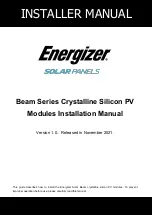
12
8 Star Energy Pty Ltd | Level 35, 477 Collins Street, Melbourne VIC 3000 | https://www.energizersolar.com
8 Star Energy ESS Ltd | The Black Church, St Mary’s Place, Dublin DO7 P4AX, Ireland
7 Electrical installation
7.1 Installation conditions
For details of the electrical performance parameters
of
Energizer
Solar PV modules, please refer to the
PV module product manual.
Rated electrical characteristics such as Isc is within
±5% and Voc within ±3% and Pmpp within ±3% of
tolerance values at Standard Test Conditions.
Standard Test Conditions: 1000W/m2 Irradiance,
25
℃
Cell Temperature and 1.5 Air Mass.
The IEC & UL standard maximum system voltage for
the regular module series is 1500V according to the
requirements. The IEC & UL standard maximum
system voltage for half-cell module series is 1500V.
The maximum voltage of the system must be less
than the maximum certified voltage and the
maximum input voltage of the inverter and of the
other electrical devices installed in the system. To
ensure that this is the case, the open circuit voltage
of the array string needs to be calculated at the
lowest expected ambient temperature for the
location. This can be done using the following
formula.
Max System voltage ≥ N * Voc * [1 + TCvoc x
(Tmin-25)]
N: the number of photovoltaic modules in a single string;
Voc: the open circuit voltage of each photovoltaic module
(refer to the photovoltaic module nameplate or product
brochure);
TCvoc: the temperature coefficient of the photovoltaic
module open circuit voltage (refer to the photovoltaic
module product brochure);
Tmin: Minimum ambient temperature.
•
Under normal conditions, a photovoltaic
module
is
likely
to
experience
conditions that produce more current
and/or voltage than reported at standard test
conditions. Accordingly, the value of Isc marked
on this module should be multiplied by a factor
of 1.25 when determining component conductor
ampacities, fuse sizes, and size of controls
connected to the PV output.
•
Refer to Section 690-8 of the National Electrical
Code for an additional multiplying factor of
125% (80% derating
)
which may be applicable.
That means, when determining the voltage
rating, conductor capacity, fuse rating, and
photovoltaic output control size, the parameters
need to be multiplied by the square of 1.25.
•
According to the max fusing rate of modules
and local electical installation standard, the
parallel connection of PV module arrays should
use the proper fuse to protect the circuit.
7.2 Installation conditions
In order to ensure the normal operation of the
system, when connecting photovoltaic modules or
connecting loads (such as inverters, batteries, etc.),
observe to ensure that the polarity of the cable is
connected correctly. If the PV module is not
connected correctly, the bypass diode may be
damaged. Figure 12 shows the connection of
photovoltaic modules in series and parallel. PV
photovoltaic modules can be wired in series to
increase the voltage. The series connection is to
connect the wiring from the positive terminal of one
photovoltaic module to the negative terminal of the
next photovoltaic module. PV photovoltaic modules
can be connected in parallel to increase current.
Parallel connection is to connect the wiring from the
positive terminal of one photovoltaic module to the
positive terminal of the next photovoltaic module. If
the PV module is not connected correctly, the
bypass diode may be damaged.

































